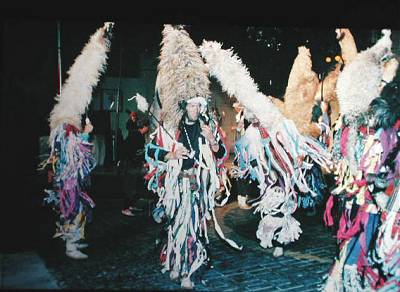| The Dalmatian Hinterland, an integral part of the
southern Croatian region of Dalmatia whose music culture
I am studying, has been the scene of tumultuous
historical events, which have directly influenced the
music culture of its people. It is largely inhabited by a
population called Morlaci [Morlachs or
Morlacchi] or Vlaji [Vlachs or Wallachs] who
engage in cattle breeding for a living. The term Morlacchi
was first mentioned in documents in 1352 (Novak,
1971: 580; Gulin, 1997: 82), both as a toponym and as the
name for the native population, first Romanized and then
Slavenized, which is distinctive on several levels: it
designates Christians (as opposed to Muslims), peasants
(as opposed to urban-dwellers), and inhabitants of
hinterlands (as opposed to the coastal and island
populations) (Gulin 1997:82) (1).
It is a fascinating to learn how many wars have swept
through this relatively small region over the last two
thousand years, how many people have settled there, moved
away or simply disappeared, and how many cultures have
left their traces in the population which is of Illyrian,
Romanic and Slavic origins. One must not omit the
religions, which have been present in this region
throughout history - polytheism, Roman Catholicism,
Christian Orthodoxy and Islam. The traces of that can be
witnessed even today in villages whose names such as Islam
Grcki and Islam Latinski (2)
designate inhabitants of diverse religious and,
indirectly, of diverse ethnic affiliation. However, these
factors did not influence their mutually very similar
modes of communication through music. To gain a better perception of Hinterland culture I began, at the outset, to examine travelogues and official reports from the 18th and 19th centuries. The original objective of these writings was political in nature - to inform their writers' governments (either Venetian or Austro-Hungarian) about the way of life of the people living alongside the unstable Venetian-Ottoman border, and to try to predict what their reactions would be in the event of military operations. The reports usually speak of three groups who live in the region - islanders, coastal-dwellers (Boduli), and mountain-dwellers (Morlaki, Vlaji). The last one are depicted as having the typical characteristics of Rousseau's imaginary "noble savage" (Gulin, 1997: 84): they are strong, tough, hearty - but sincere, hospitable, honest, noble, and reliable.
European readers discovered the culture of the Dalmatian Hinterland at the end of the 18th century through a travel accounts. The term Morlacchism infers the European reception of information on the Dalmatian hinterland of the 18th century, that is, of its customs, beliefs, the way of life of this population, and their music culture (3). Alberto Fortis' Viaggio in Dalmazia [Traveling Across Dalmatia] and its chapter Manners of the Morlacchi, dating from 1774, and Ivan Lovric's Biljeske o putu po Dalmaciji opata Alberta Fortisa [Notes on the Journey Across Dalmatia by the Abbot Alberto Fortis] dating from 1776, were the first capital works of this kind of literature. They contained detailed descriptions of the life of the Morlachs and were translated into several European languages. This barbarian people was described with terms such as natural, untouched by civilization and unspoiled, old, original, uneducated and inverted, hospitable, warm, fond of weapons, fatalistically oriented and superstitious (4). Reading these texts one can learn about the Morlacchian stance towards music, which was part of their everyday lives. The most common founds in these works are descriptions of singing and situations in which there is singing. All the authors emphasized the attitude of the Morlachs towards singing, which they practiced with enthusiasm:
The writers admired the Morlach songs full of lively images and imagination, which had a powerful effect on the souls of listeners. All the writers of that period gained the same impression of this music - a wild and primitive, undefined music style, which could not be compared with the music phenomena they were used to. While Fortis noticed "a unique phenomena of poetry and music" (Fortis, 1984 [1774]:185), Yiarte described their music-making as an "amorphous artistic phenomenon" (Yiarte in Dobronic, 1915: 8), Noe's impression was of "something which cannot be described" (Noe in Dobronic, 1915: 8), Petter describes "music different from yodeling and piping" (Petter, 1857: 200), while Carrara "noticed oriental elements" (Carrara 1846: 183) in this mountain folk singing. As a man whose origins were in these areas, Lovric showed a meticulous approach to the singing and music-making of the Morlachs, also describing the behavior of listeners during the performance and their attitude to other musics:
Lovric also criticized Fortis about his failing "... to notice that some customs are changed" (Lovric,1948: 58). Lovric saw change in many aspects of life, and also recognized the time dimension (then - in olden times, recently - today), claiming that some customs had changed, while others had been "abolished". Besides, Lovric emphasized changes more in the possession aspect than Fortis did - those changes reflect in cultural as well as in social life. More attention to style and the music traits of singing is given by researchers at the end of the 19th and beginning of the 20th century, although they did not discuss the changes in music forms and music-making during that period. |
